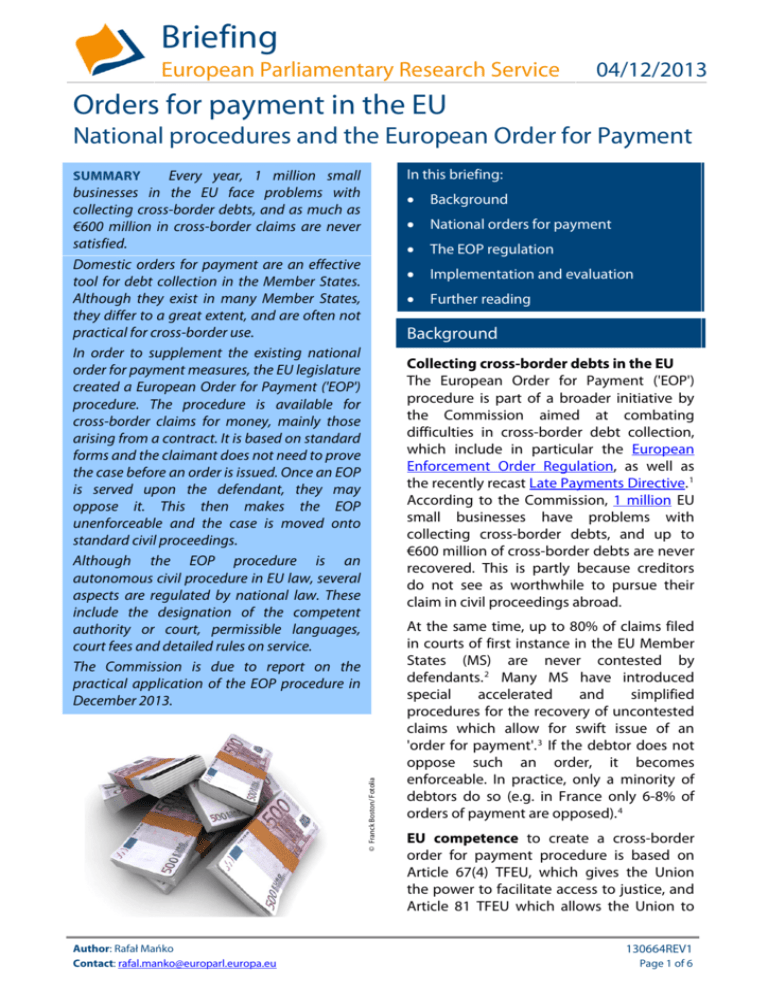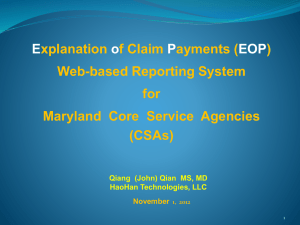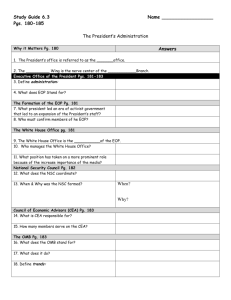
Briefing
European Parliamentary Research Service
04/12/2013
Orders for payment in the EU
National procedures and the European Order for Payment
In this briefing:
Every year, 1 million small
businesses in the EU face problems with
collecting cross-border debts, and as much as
€600 million in cross-border claims are never
satisfied.
Domestic orders for payment are an effective
tool for debt collection in the Member States.
Although they exist in many Member States,
they differ to a great extent, and are often not
practical for cross-border use.
In order to supplement the existing national
order for payment measures, the EU legislature
created a European Order for Payment ('EOP')
procedure. The procedure is available for
cross-border claims for money, mainly those
arising from a contract. It is based on standard
forms and the claimant does not need to prove
the case before an order is issued. Once an EOP
is served upon the defendant, they may
oppose it. This then makes the EOP
unenforceable and the case is moved onto
standard civil proceedings.
Although the EOP procedure is an
autonomous civil procedure in EU law, several
aspects are regulated by national law. These
include the designation of the competent
authority or court, permissible languages,
court fees and detailed rules on service.
The Commission is due to report on the
practical application of the EOP procedure in
December 2013.
SUMMARY
Background
National orders for payment
The EOP regulation
Implementation and evaluation
Further reading
Background
Collecting cross-border debts in the EU
The European Order for Payment ('EOP')
procedure is part of a broader initiative by
the Commission aimed at combating
difficulties in cross-border debt collection,
which include in particular the European
Enforcement Order Regulation, as well as
the recently recast Late Payments Directive. 1
According to the Commission, 1 million EU
small businesses have problems with
collecting cross-border debts, and up to
€600 million of cross-border debts are never
recovered. This is partly because creditors
do not see as worthwhile to pursue their
claim in civil proceedings abroad.
© Franck Boston/ Fotolia
Author: Rafał Mańko
Contact: rafal.manko@europarl.europa.eu
At the same time, up to 80% of claims filed
in courts of first instance in the EU Member
States (MS) are never contested by
defendants. 2 Many MS have introduced
special
accelerated
and
simplified
procedures for the recovery of uncontested
claims which allow for swift issue of an
'order for payment'. 3 If the debtor does not
oppose such an order, it becomes
enforceable. In practice, only a minority of
debtors do so (e.g. in France only 6-8% of
orders of payment are opposed). 4
EU competence to create a cross-border
order for payment procedure is based on
Article 67(4) TFEU, which gives the Union
the power to facilitate access to justice, and
Article 81 TFEU which allows the Union to
130664REV1
Page 1 of 6
Briefing
develop judicial cooperation in civil matters
with cross-border implications.
National orders for payment
Civil procedures in many MS (e.g. UK, France,
Germany, Italy, Poland and Spain), have
simplified order for payment proceedings
for the recovery of uncontested claims.
There are differences between national
procedures, especially with regard to the
extent of evidence the claimant must
produce, and the exact consequences of the
defendant's lack of reaction.
In England and Wales a summary
judgment may be pronounced, without
trial, if the court considers that either the
claimant or defendant has no real prospect
of making their case. They are available in all
types of civil cases and are issued after the
defendant has acknowledged service of the
application or filed a defence. They are
subject to appeal.
An English court may give a default
judgment, without trial, if the defendant
has not acknowledged service of the
application or has failed to file a defence
within the deadline. They are allowed only
for claims for money or for delivery of
goods. They may not be appealed, but the
defendant may ask the court to set them
aside. The court will do so only if it considers
that the defendant has a strong case or
there are other compelling reasons. Default
judgments are issued by two specialised,
on-line centres – the Claims Production
Centre ('CPC') which works for major
claimants (e.g. banks, credit card companies,
debt recovery firms) and the Money Claim
Online service available to one-off claimants.
In France an order for payment is available
for claims for money owed under a contract.
The claimant must produce supporting
evidence. A judge analyses the application
and may issue an order of payment, which
the defendant can then oppose within one
month. Opposition automatically moves the
case onto standard civil proceedings.
Author: Rafał Mańko
Contact: rafal.manko@europarl.europa.eu
Orders for payment in the EU
In Germany an order for payment can be
sought for claims for money. Applications
are processed in a part-automated
procedure, overseen by court clerks.
Evidence is not analysed. Parties must use
standard forms (paper or electronic). The
procedure has two stages: first the court
issues a warning notice, and if the defendant
does not react, a notice of enforcement. If
the defendant still fails to react, the order
becomes enforceable. If the defendant
reacts in time, the court will consider setting
the order for payment aside.
Orders for payment are available in Italy to
creditors pursing claims for money or for
delivery of goods. The court decides on the
basis of evidence provided by the claimant,
without hearing the debtor. Once the order
for payment is issued, the defendant may
launch an opposition which automatically
moves the case onto standard civil
proceedings.
Creditors in Poland have three alternative
tracks for obtaining an order for payment. 5
In injunction proceedings, the claimant
must prove the claim by producing
documentary evidence (e.g. invoice,
contract, bill of exchange, cheque). If the
court is satisfied with the evidence, it issues
an order for payment without a hearing.
Thereupon, the defendant may raise
defences which the court will analyse and
either uphold the order, or (partly) annul it.
Another option available is monition
proceedings, where the court issues an
order of payment on the basis of
information provided by the claimant,
without the need to produce evidence. The
defendant then has two weeks to oppose it
which automatically sets aside the order for
payment and the case is moved to standard
civil proceedings. There are also electronic
monition proceedings, available only for
claims less than three years old, where
electronic forms are used.
In Spain monition proceedings are available
for claims for money up to €30 000, which
130664REV1
Page 2 of 6
Briefing
have fallen due and can be proven by
documents (e.g. invoices), which must be
attached to the claim. On the basis of the
documents presented by the claimant, the
court issues an order for payment, setting a
deadline for the defendant to satisfy or
oppose the claim. Opposition moves the
case onto standard civil proceedings.
The EOP Regulation
In order to supplement existing national
order for payment procedures, the EU
adopted the European Order for Payment
Procedure in Regulation No 1896/2006
which has applied since December 2008 in
all MS except Denmark. The main aim of the
EOP procedure is to simplify, accelerate and
reduce the costs of cross-border civil
litigation concerning uncontested claims for
money. For this reason, at all stages of the
EOP procedure, claimants, defendants and
courts are obliged to use standard forms.
The EOP procedure is available for crossborder claims for money. At least one
party (the claimant or the defendant) must
be domiciled or habitually resident in an MS
different from the one, where the claim is
filed (even if both live in the same MS).
There are no minimum or maximum
thresholds as to the value of the claim,
making it useful also for claims under
business-to-business contracts. 6 Claims for
money arising from marriage or succession,
as well as all public-law claims (revenue,
taxes, administrative law, social security...)
are excluded. Claims arising from noncontractual obligations are allowed only if
the parties have agreed to their amount or if
the debtor admitted the debt.
The EOP procedure is intended to be an
additional and optional way of pursuing
claims. Claimants may still use national
procedures even in cross-border cases.
Furthermore, the Regulation does not affect
national order for payment procedures. With
regard to certain aspects, such as the
competent court, court fees or details of
service (delivery) of documents, the
Author: Rafał Mańko
Contact: rafal.manko@europarl.europa.eu
Orders for payment in the EU
regulation refers to national law.
Otherwise, however, it is a self-contained
and autonomous EU civil procedure. 7
Formal requirements
All the requirements for filing an EOP
application are exhaustively set out in the
Regulation, and no additional formalities
may be imposed by national law (Szyrocka
case, 2012). An application must identify the
claimant and defendant, specify the amount
of money sought, contain a description of
the facts upon which the claim is based, a
description of evidence (but not the
evidence itself), and justification that the
case is a cross-border one. National law may
set penalties for deliberately providing false
statements in the application. If the
application does not conform to the
requirements, the court may ask the
claimant to correct it.
Jurisdiction of courts
An application for an EOP is filed in a court
which is competent under the Brussels I
Regulation (as from 2015 – under the recast
Brussels Ia Regulation). However, consumers
may be sued only in the MS where they are
domiciled. Whenever Brussels I allows it, the
EOP procedure may also be used by
creditors situated outside the EU to sue a
debtor in an MS, and by creditors from
within the EU to sue debtors from outside
the Union, if an MS court has jurisdiction. 8
Examination of application
The court in which an EOP application has
been launched examines it from the point of
view of formal requirements. It also checks
whether the claim appears to be founded,
but does not analyse any evidence. The
examination of an EOP application may
even be automated.
Issue of an EOP
If all the formal requirements are met and
the claim appears to be founded, the court
issues an EOP. This should normally happen
within 30 days of filing the application, but
there is no concrete obligation on the
court. 9 An EOP informs the defendant that
130664REV1
Page 3 of 6
Briefing
they may either pay the debt or file a
statement of opposition within 30 days of
receiving it.
Service on the defendant
The EOP procedure is not adversarial and
the defendant becomes aware of an EOP
only when it is served on them. 10 This makes
the rules on service essential from the point
of view of safeguarding defendants'
interests. Service is governed by the law of
the MS in which it is to take place. It may
either be effected with proof of receipt, or –
if the defendant's address is known – even
without such proof.
Possibilities of challenging an EOP
Defendant's statement of opposition
The intent of the Regulation is to speed up
cross-border civil proceedings, but only as
long as the claim remains uncontested. 11
Hence, once a defendant files a statement of
opposition, the EOP automatically loses its
force and the case is transferred to standard
civil proceedings. A statement of opposition
does not need to contain any specific
arguments.
The filing of an opposition does not have
any impact upon jurisdiction of courts. A
defendant who files an opposition
containing arguments on the merits, may
still question the jurisdiction of courts of an
MS in the ordinary proceedings that follow
(Sperindeo case, 2013).
Defendant's application for review
After the expiry of the time limit for
launching a statement of opposition, the
defendant may still apply for a review of the
EOP before the court which issued it.
However, this is allowed only in exceptional
cases: if the order was not delivered to the
defendant or the defendant was prevented
from launching a statement of opposition
because of extraordinary circumstances and
not through their own fault. Upon review of
the EOP, the competent court may either
uphold or annul it.
Author: Rafał Mańko
Contact: rafal.manko@europarl.europa.eu
Orders for payment in the EU
Enforcement of the EOP
Declaration of enforceability
If the defendant does not file a statement of
opposition within the prescribed deadline,
the court which issued the EOP declares it to
be enforceable and sends the EOP to the
claimant. An EOP is automatically
recognised and enforceable in all MS,
without the need to seek any additional
declaration of enforceability.
Formal requirements
Enforcement proceedings are outside the
scope of the Regulation, and are governed
by the law of the MS where enforcement is
sought. However, some common rules
apply.
Limited possibility of challenging enforcement
In strictly limited cases, the defendant may
ask the competent court of the MS of
enforcement not to enforce the EOP. This is
possible if the same dispute has already
been decided upon in an earlier judgment
which is enforceable, and the defendant did
not have the opportunity to raise this
objection earlier or if the defendant had
already paid the debt in the meantime.
Implementation and evaluation
Implementation in the MS
MS are free to indicate which courts or
authorities will be responsible for
processing EOP applications. Whilst some
countries (e.g. Poland, England & Wales)
have entrusted courts of ordinary
jurisdiction with this task, others (e.g.
Germany, Austria) have designated only one
specialised court. Furthermore, in Sweden
EOP applications are processed by a
centralised administrative authority. In some
MS (e.g. Austria) EOP applications are
processed not by judges, but by court clerks.
As to penalties for making false statements
in EOP applications, in England and Wales,
such claimants may face proceedings for
contempt of court, and in France they may
face up to five years in prison and €375 000
in penalties. 12
130664REV1
Page 4 of 6
Briefing
Various approaches have been taken as
regards the service of an EOP; in France it is
possible only by an enforcement officer, in
Poland it may be done by post. Some
countries allow electronic communication,
while others have excluded it.
EOP in court practice
General overview
In general, the number of EOP applications
is much lower than for national orders for
payment. 13 The number of EOP applications
is low both in proportion to all order for
payment applications (0.2% in Sweden, 0.4%
in Austria, 1% in Germany) as well as in
absolute numbers (35 applications yearly in
Sweden, 95 in the UK). In Austria there were
a fairly high number of EOP applications
filed (2 177) but this number is relatively low
compared to the 507 000 applications for a
national order for payment in that MS.
Focus on Poland
The Polish Institute of Justice has recently
published a detailed empirical study on the
topic, containing case-by-case analysis of
court practice regarding the EOP. 14 The
study revealed that most EOP applications
(87%) were filed in Polish courts by
claimants domiciled in Poland against
parties from another MS. This is possible, for
instance, if the jurisdiction of Polish courts is
foreseen in the contract.
In 64% of the cases the court issued an EOP
directly following the application, whilst in
34% cases the claimant was asked to correct
the application, e.g. by paying the
appropriate amount in court fees. Where
there was no need to correct the
application, courts needed on average 33
days to issue an EOP. Only in 7% of cases did
defendants file a statement of opposition,
meaning that 93% of EOPs remained
uncontested. However, only in 73% of cases
did the courts declare an EOP enforceable
on their own motion. In the remaining cases,
they waited for a request from the claimant,
a step not set out in the Regulation.
Author: Rafał Mańko
Contact: rafal.manko@europarl.europa.eu
Orders for payment in the EU
The analysis revealed that the rules of the
Regulation are interpreted and applied in
divergent ways, often contrary to the
purposes of the Regulation. For instance, in
several cases courts required the claimant to
pay in advance for the costs of translation,
without checking first whether it was really
necessary. In some cases courts demanded
that the claimant provide the documents
supporting the claim, although the
Regulation does not require this. Polish
courts usually sent the EOP abroad by post,
without checking if this method is
acceptable in a specific MS.
Academic proposals
Soraya Amrani-Mekki 15 (Paris) points out
that the jurisdiction rule whereby the
defendant may be sued only in the courts of
their own MS extends only to consumers,
meaning employees and insured persons
may face an EOP procedure abroad.
Furthermore, she proposes to strengthen
the protective rule, to make it explicit that a
court or authority must, before issuing an
EOP, verify its competence.
Carla Crifò 16 (Leicester) believes that too
much has been left to national law, which
can create the risk of divergent application
of the Regulation across the EU. This could
be remedied by frequent references to the
CJEU, but in practice courts may be more
eager to fill the gaps in the Regulation with
national law. She has also made proposals
for rules which could be added to the EOP,
instead of leaving the matter to national law
(e.g. rules on withdrawing an application,
and on specification of the moment when
proceedings are deemed to have started).
Elena Alina Ontanu and Ekaterina
Pannebaker 17 (Rotterdam) propose that the
Regulation be supplemented by clear
language rules, instead of leaving the matter
to national law. As a hypothetical solution
they consider using only English across the
EU for commercial EOP proceedings. They
also consider resorting to automated
translation in order to cut down costs.
130664REV1
Page 5 of 6
Briefing
Orders for payment in the EU
Xandra Kramer 18 (Rotterdam) points out that
important issues, especially the rules on
service, have been left to national law, which
can lead to a situation in which MS uphold
their own inefficient rules. She also
advocates the enactment of more detailed
rules on the scope of 'review' of an EOP.
Kramer proposes that ideally the EOP should
be an entirely electronic procedure. She also
suggests that explanatory guidelines for
national courts should be published.
judgments and orders for payment / Carla Crifò,
Alphen a/d Rijn: Kluwer Law International, 2009.
Review by the European Commission
By December 2013, the Commission should
present a detailed report reviewing the
operation of the EOP procedure. It will
contain a detailed impact assessment for
each MS.
This briefing is a summary of published information and
does not necessarily represent the views of the author or
the European Parliament. The document is exclusively
addressed to the Members and staff of the European
Parliament for their parliamentary work. Links to
information sources within this document may be
inaccessible from locations outside the European
Parliament network. © European Union, 2013. All rights
reserved.
Further reading
Cross-border enforcement of debts in the
European Union : default judgments, summary
Droit processuel civil de l'Union européenne /
ed. Loïc Cadet, Emmanuel Jeuland, Soraya
Amrani-Mekki, LexisNexis, 2011.
Implementation of optional instruments within
European civil law / Bénédicte FauvarqueCosson, Martine Behar-Touchais, EP Policy
Department C study, 2012
Disclaimer and Copyright
http://www.library.ep.ec
http://libraryeuroparl.wordpress.com
Endnotes
1
Civil Procedure and EU Law: A Policy Area Uncovered / Eva Storskrubb, Oxford University Press, 2008, p. 203.
2
Storskubb, op.cit, p. 204; Europejski nakaz zapłaty w praktyce sądowej [The European Order for Payment in Court Practice] /
Piotr Rylski, in: Prawo w Działaniu – Sprawy Cywilne, 2012, vol. 12, pp. 145-190, p. 147.
3
Cross-border enforcement of debts in the European Union: default judgments, summary judgments and orders for payment /
Carla Crifò, Kluwer Law International, 2009, p. 151-254.
4
Storskubb, op.cit., p. 204-205.
5
See Polish Code of Civil Procedure, art. 4841–497; art. 4911–505; art. 50528-50538.
6
Commercial Litigating in the European Union: A Changing Landscape / Luc Demeyere, in: International Business Law Journal,
2008, vol. 4, pp. 481-508, p. 500.
7
Storskrubb, op.cit., p. 143; A major step in the harmonisation of procedural law in Europe: the European Small Claims
Procedure: Accomplishments, new features and some fundamental questions of European harmonisation / Xandra Kramer, in:
The XIIIth World Congress of Procedural Law. The Belgian and Dutch Reports, 2008, p. 1; Rylski, op.cit., p. 145.
8
Règlement (CE) no. 1896/2006 du 12 décembre 2006 instituant une procédure européenne d'injonction de payer / Soraya
Amrani-Mekki, in: Droit processuel civil de l'Union européenne, LexisNexis 2011, pp. 249-275, p. 253.
9
Storskrubb, op.cit., p. 214.
10
CJEU Case C-144/12 Sperindeo, para. 29.
11
CJEU Case C-144/12 Sperindeo, para 42.
12
Amrani-Mekki, op.cit, p. 258. See Art. 313-1 and 441-1 of the French Penal Code.
13
Implementation of optional instruments within European civil law, EP Policy Department C study, 2012, p. 108-115.
14
Rylski, op.cit., passim.
15
Amrani-Mekki, op.cit, p.257-258.
16
Crifò, op.cit., p. 103-147.
17
Tackling language obstacles In cross-border litigation: The European Order for Payment and the European Small Claims
Procedure approach / Elena Alina Ontanu and Ekaterina Pannebakker, in: Erasmus Law Review, 2012, vol. 5, issue 3.
18
Kramer, op.cit..
Author: Rafał Mańko
Contact: rafal.manko@europarl.europa.eu
130664REV1
Page 6 of 6


![[school/department/work unit] EOP](http://s3.studylib.net/store/data/007019024_1-9182da65872ec3349f5f8dad4e6a3909-300x300.png)






